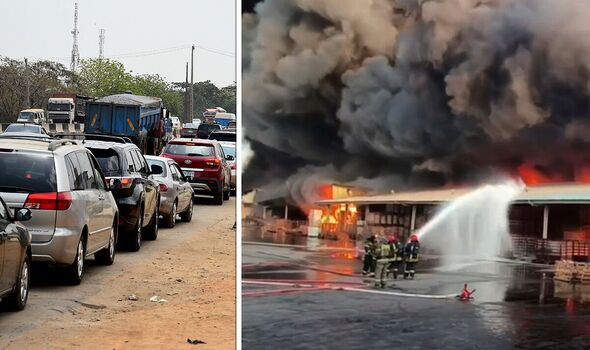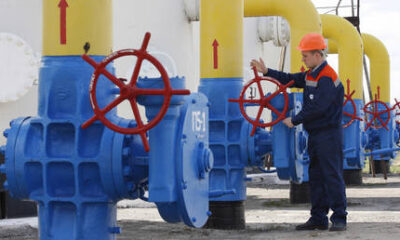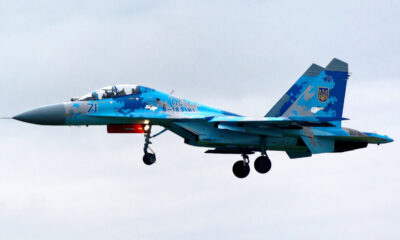World
Fuel Crisis Hits Russia as Petrol Stations Run Dry and Rationing Begins

Russia is grappling with a severe fuel crisis as petrol stations across the country face shortages, leading to long queues of motorists and the introduction of rationing in several regions. This situation has been exacerbated by a series of drone strikes from Ukraine targeting oil refineries and infrastructure, significantly disrupting production and pushing prices to unprecedented levels.
In recent weeks, Ukrainian drone attacks have caused a dramatic decline in Russian oil output. As a result, wholesale prices for A-95 petrol surged on the St Petersburg International Mercantile Exchange, reaching approximately 50% higher than prices recorded in January. The spike comes as demand increases, particularly from farmers needing fuel for harvest and families preparing for end-of-summer travels.
Reports indicate that petrol stations in the Far East and on the illegally annexed Crimean Peninsula are particularly hard-hit. In the Primorye region, which borders North Korea, consumers have encountered long lines and prices around 78 roubles per litre (approximately $3.58 per gallon). Local journalists at Primpress have documented individuals attempting to sell petrol online for as much as 220 roubles per litre (about $10.12 per gallon).
The situation is dire in the Kurilsky district of the Kuril Islands, where shortages of lower octane A-92 petrol have led authorities to halt public sales completely. In Crimea, limited fuel sales are now restricted to holders of special coupons or cards, further complicating access for consumers.
This year’s fuel shortages are particularly alarming, as they coincide with traditional price increases typically seen at the end of summer. The ongoing conflict with Ukraine has intensified these shortages. Ukrainian forces have effectively targeted a concentrated arc of oil refineries stretching from Ryazan to Volgograd, disrupting operations in a region crucial for travel to Black Sea resorts and agricultural activities.
According to Sergey Vakulenko, a senior fellow at the Carnegie Russia Eurasia Center, the recent drone strikes have been markedly effective, damaging key facilities without completely destroying them. He explained, “The Ukrainians are attacking an arc of refineries, starting from Ryazan, which is south of Moscow, all the way to Volgograd. That region is where most of the harvest operations are going on.”
The ongoing crisis has also been fueled by broader issues linked to the war. Disruptions to Russian transportation networks, particularly air traffic, have led to increased reliance on road travel, thereby driving up demand for petrol. Furthermore, inflation has hindered suppliers, many of whom have opted not to procure fuel early in the year for summer sales, impacting overall availability.
Reports indicate that between August 2 and August 24, 2023, Ukraine launched at least 12 attacks on oil infrastructure, primarily targeting facilities in southwestern Russia. These strikes have reduced crude oil processing by approximately 200,000 to 250,000 barrels per day, according to Gary Peach, an oil markets analyst at Energy Intelligence. He noted, “That’s just enough to make their gasoline industry feel some pain, especially during the high consumption months in the summer.”
While petrol production has plummeted—down 8.6% in early August compared to the previous year—diesel production remains robust. Experts suggest that the current crisis is not critical for the overall economy, as Moscow continues to receive adequate supplies from major refineries. The city benefits from its own operational refinery and is insulated from the immediate impacts felt elsewhere.
Despite this, the situation could deteriorate if conditions do not improve. Key refinery equipment targeted in the drone strikes, such as distillation columns, must be repaired or replaced for production to resume effectively. Repairs may pose challenges, particularly if foreign parts or expertise are required, complicating recovery efforts.
The petrol crisis is anticipated to ease by late September as summer demand subsides and annual maintenance for many refineries concludes. Still, this crisis underscores vulnerabilities within Russia’s domestic fuel infrastructure, vulnerabilities that could be further exploited as drone warfare evolves in the ongoing conflict.
-

 Entertainment1 month ago
Entertainment1 month agoAnn Ming Reflects on ITV’s ‘I Fought the Law’ Drama
-

 Entertainment2 months ago
Entertainment2 months agoKate Garraway Sells £2 Million Home Amid Financial Struggles
-

 Health1 month ago
Health1 month agoKatie Price Faces New Health Concerns After Cancer Symptoms Resurface
-

 Entertainment2 months ago
Entertainment2 months agoKim Cattrall Posts Cryptic Message After HBO’s Sequel Cancellation
-

 Entertainment1 month ago
Entertainment1 month agoWhere is Tinder Swindler Simon Leviev? Latest Updates Revealed
-

 Entertainment1 month ago
Entertainment1 month agoCoronation Street’s Carl Webster Faces Trouble with New Affairs
-

 Entertainment2 months ago
Entertainment2 months agoMasterChef Faces Turmoil as Tom Kerridge Withdraws from Hosting Role
-

 Entertainment3 months ago
Entertainment3 months agoSpeculation Surrounds Home and Away as Cast Departures Mount
-

 World1 month ago
World1 month agoCole Palmer’s Mysterious Message to Kobbie Mainoo Sparks Speculation
-

 Entertainment1 month ago
Entertainment1 month agoITV’s I Fought the Law: Unraveling the True Story Behind the Drama
-

 Entertainment4 weeks ago
Entertainment4 weeks agoCaz Crowned Winner of The Great British Sewing Bee, Overjoyed by Triumph
-

 Entertainment2 months ago
Entertainment2 months agoAldi Launches Cozy Autumn Fragrance Range Ahead of Halloween





















